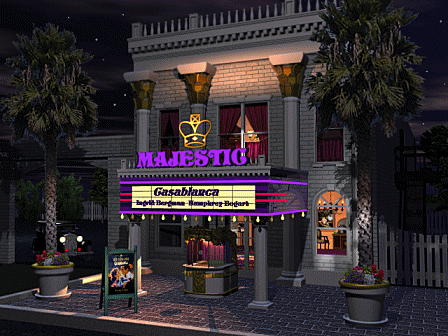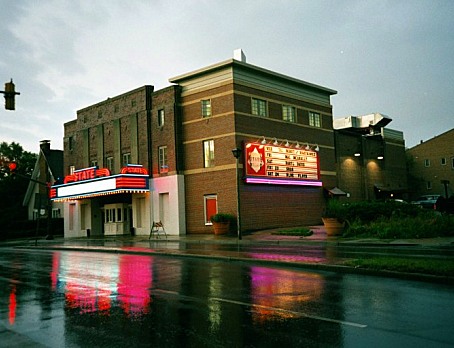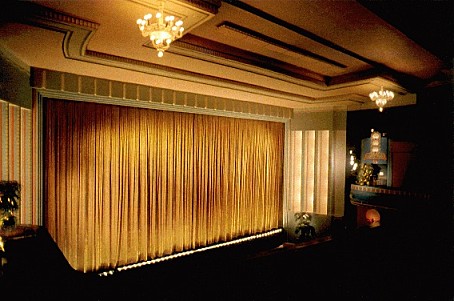


"Majestic
Theatre" 3D Graphic © 2000 Jo
Baldwin

 Ever
since the invention of motion pictures there have been
audiences and buildings to accomodate them. The earliest of these
"movie houses" were usually old vaudeville theatres, town halls,
arcades, schools and even churches. Often the setup for viewing films
was no more than a large sheet used for a screen, a few benches and a
curtain that separated the ticket lobby from the screen area.
 The
first establishment built specifically for viewing movies was
Tally's Electric Theatre in Los Angeles in 1902. Soon movie houses were
springing up all over the country. When it became apparent that the
movies were here to stay, immense lavish theatres were built called
"palaces". The first of these was constructed in 1913 in New York City
and was called The Regent.
 Between
1914-1922, 4,000 new theatres were opened. The palaces were
truly grand, sometimes seating thousands of patrons. They were
decorated in extravagant eclectic styles where no detail was spared.
The largest palaces provided their customers with medical attendents in
case of emergencies, nurseries and even pet boarding services! They
contained posh smoking lounges, restrooms and powder rooms. Carefully
trained ushers dressed in fancy attire politely attended to all the
patrons' needs.

Newly
Refurbished Circa 1930's State
Theatre, Falls Church, Virginia

 During
the era of the "silents",
live orchestras and theatre organs provided music and sound effects to
accompany the films. The theatre
organ was truly a magnificent invention capable of
reproducing a full symphony of sound. It was also used to duplicate
numerous sound effects such as ringing telephones, birds singing,
rushing wind, etc. Unfortunately its role in movie history was
shortlived. With the invention of "talkies" by the year 1929, the
theatre organ fell into disuse. It was then relegated to live stage
shows and religious gatherings.  By
1930 the Art Deco
era had arrived. The clean modern lines and geometric tile
patterns of this architectural style resulted in a new type of palace
theatre. Radio City Music Hall which opened in 1932 is a fine example
of this type of architecture. 1933 saw the arrival of the first outdoor
theatre called a "drive-in"
in Camden, New Jersey. These theatres quickly became popular and by the
mid 1950's over 4,000 of them had spread across the country. By
1930 the Art Deco
era had arrived. The clean modern lines and geometric tile
patterns of this architectural style resulted in a new type of palace
theatre. Radio City Music Hall which opened in 1932 is a fine example
of this type of architecture. 1933 saw the arrival of the first outdoor
theatre called a "drive-in"
in Camden, New Jersey. These theatres quickly became popular and by the
mid 1950's over 4,000 of them had spread across the country.

Astor
Cinema in Melbourne, Australia
© Ron Israel for Kino Cinema
Quarterly

Music
playing is "Lights! Camera! Action!"
Sequence Copyright 1999
by Blue Max Distribution
Visit Gary
Wachtel's Home Page
|